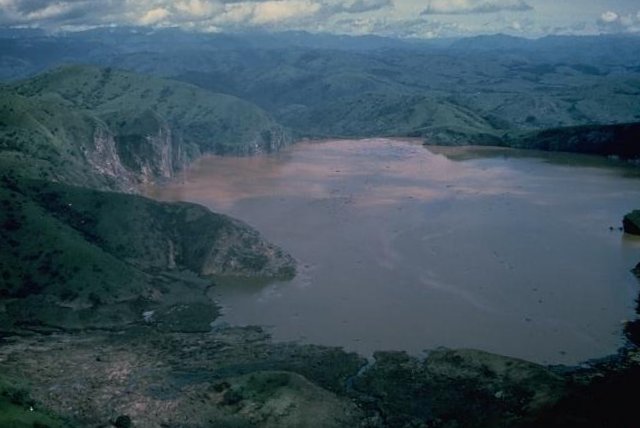They had died suddenly, at the same time. There were no apparent wounds or signs of injury on the corpses, aside from sores that developed on some of the survivors. At first thought to be a chemical or biological weapon, the devastation had come from the lake itself, an extremely rare natural disaster known as a ‘limnic eruption’.
Although you wouldn’t be able to tell by looking at it, Lake Nyos is volcanic. The lake was formed in the crater of a gigantic volcanic explosion, and while the volcano itself is extinct, a large amount of magma still rests beneath the lakebed. This volcanic activity saturates the water with various gases, notably carbon dioxide, which makes it an incredibly uncommon type of volcanic lake – one of only three on the entire planet. Denser layers of cold water trap the CO2 far below the surface of the lake, where it continues to build and build and build until pockets holding millions of tonnes of co2 sit beneath the waters. This is exactly what occurred in 1986, the gas pocket had been growing in volume for decades, perhaps even centuries. What caused the gas pocket to erupt is unknown but is most commonly thought to have been a rockslide which broke the surface tension of the water, releasing the gas. Other possible explanations are that cold rain falling on the warm surface of the lake altered the pressure difference between the top and bottom and caused the release, or a small volcanic eruption at the bottom of the lake. When the eruption occurred survivors living near the lake described a loud bang, like an explosion. Others saw mist-like white vapour rising from the surface of the water – these phenomena were followed by feelings of nausea, hallucinations, foul smells and unconsciousness. When survivors woke up, they were greeted by a truly horrific sight – people, livestock, marine life and even the insects were dead. Speaking to researchers from San Diego State university, a survivor named Joseph Nkwain recounted his harrowing ordeal:
“I could not speak. I became unconscious. I could not open my mouth because then I smelled something terrible … I heard my daughter snoring in a terrible way, very abnormal … When crossing to my daughter’s bed … I collapsed and fell. I was there till nine o’clock in the (Friday) morning … until a friend of mine came and knocked at my door … I was surprised to see that my trousers were red, had some stains like honey. I saw some … starchy mess on my body. My arms had some wounds … I didn’t really know how I got these wounds … I opened the door … I wanted to speak; my breath would not come out … My daughter was already dead … I went into my daughter’s bed, thinking that she was still sleeping. I slept till it was 4:30 p.m. in the afternoon … on Friday. (Then) I managed to go over to my neighbors’ houses. They were all dead … I decided to leave …. (because) most of my family was in Wum … I got my motorcycle … A friend whose father had died left with me (for) Wum … As I rode … through Nyos I didn’t see any sign of any living thing … (When I got to Wum), I was unable to walk, even to talk … my body was completely weak.”
Joseph couldn’t have known but he had survived a Limnic eruption, 1.6 million tonnes of carbon dioxide had been ejected by the lake, an invisible cloud of death travelling at over 60mph, displacing all the air in 25-kilometre radius – almost instantaneously suffocating anyone unfortunate enough to be caught inside. Sores appeared on survivors skin due to the sudden change in air pressure, and iron-rich water from the lakebed was pushed to the surface, oxidising and turning the water red. Initially Joseph couldn’t speak in the aftermath of the eruption. He, like many survivors, suffered respiratory problems. But when he was able to speak again, he informed authorities of what had occurred, and a team of investigators was dispatched. Police and medical personnel were among the first to arrive at Nyos but were hesitant to go further once they started to discover bodies, for all they knew the danger was still present, as the corpses may carry some kind of pathogen or contagion. The first to enter the village was Dutch priest named Father TenHorn who described the scene as “looking like the aftermath of a neutron bomb”. TenHorn transported some bodies to a local hospital where doctors quickly determined the cause of death was suffocation and did not appear to be caused by any infection. Within days scientists from across the world descended on Lake Nyos to aid in investigation and relief efforts. A geologist named George Kling from the University of Michigan was the first to identify that the water of Nyos was saturated with incredibly high levels of Co2, and, along with a team of experts determined the cause to be a Limnic eruption. Alarmingly, Kling and colleagues found the Co2 levels of the lake were quickly replenishing and raised the possibility of another disaster. A team of French engineers spent several years planning and constructing “degassing” equipment, which consisted of a drill and a very large hose pipe which was used to release a controlled geyser of Co2, ending the lake’s threat to the local people.
Interestingly, the Bafmen – a group of indigenous people living on the upper banks of Lake Nyos – were unharmed by the disaster, as the Co2 was too heavy to travel up the steep incline. Anthropologist Eugenia Shanklin recorded Bafmen mythology and found their ancestors refused to settle near the shore, in fear of demons and malevolent spirits. These myths could very well have basis in fact; if a Limnic eruption occurred centuries ago, supernatural explanations would have been favoured.

